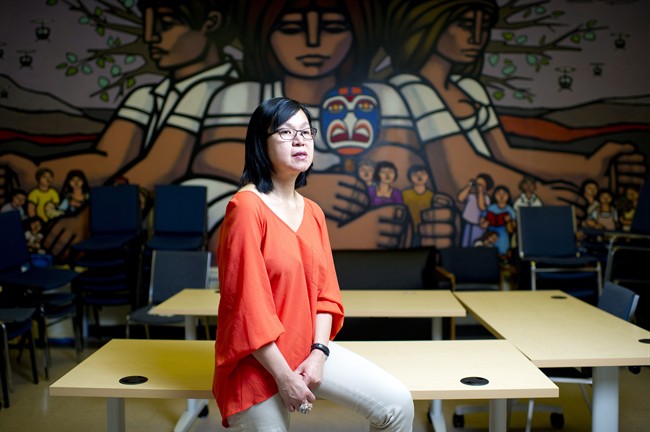British Columbia is home to the second largest foreign-born population in Canada, an ethnocultural nation where now one in five citizens are immigrants living in cities both big and small.

The data was released Wednesday by Statistics Canada based on a National Household Survey it conducted in 2011.
In that year, the data show the vast majority — 94.8 per cent — of Canada’s foreign-born population lived in Ontario, B.C, Quebec and Alberta.
B.C. had the second largest number of people born outside the country, with 1,191,900 immigrants (or 17.6 per cent) followed by Ontario with 3,611,400 immigrants (or 53.3 per cent.)
Most still lived in Metro Vancouver, accounting for 40 per cent of the region’s total population, up only slightly from 39.6 per cent in 2006, when the last household survey was conducted.
Still, it shows municipalities surrounding Vancouver continue to become more ethnically diverse. In Richmond, for example, more than half the population identified themselves as visible minorities, as did more than half of those living in Surrey.
Of all the metropolitan areas in Canada, Vancouver had the highest number of Chinese immigrants (18 per cent) and Korean (1.2 per cent) while Abbotsford-Mission had the most South Asians (19 per cent)
However, since the last survey, the province saw a marginal decline in new immigrants, or those who came to Canada between 2006 and 2011, as the number of newcomers increasingly choose other provinces to live such as Saskatchewan.
Vancouver received more than 155,100 newcomers, representing 6.8 per cent of the population. Kelowna gained 3,150 new immigrants while 5,935 settled in the Abbotsford-Mission region.

Get daily National news
Among the G8 countries, Canada had the highest proportion of foreign-born population (20.6 per cent), followed by Germany (13 per cent) and the United States (12.9 per cent).
In total, 1.2 million immigrants came to Canada between 2006 and 2011.
Most are settling in the nation’s big cities — Toronto, Montreal and Vancouver — but other cities such as Calgary, Edmonton, Winnipeg, Saskatoon, Regina and Ottawa are also seeing their cultural milieu changed by a rising tide of immigration.
During the recent five-year period, the largest share of immigrants to Canada (56.9 per cent) came from Asia and the Middle East — compared to how just 8.5 per cent of immigrants to Canada before 1970 came from that region.
All the while, Canada is experiencing mixed changes on religion. Nearly one-quarter of Canadians (23.9 per cent) had no religious affiliation last year, up from 15 per cent a decade earlier.
That’s not to say that religion is dead in Canada. About 22.1 million Canadians (67.3 per cent of the population) are Christians. Roman Catholics are the largest of that group, with 12.7 million Canadians (38.7 per cent) saying they are Catholics.
However, because of immigration patterns, other religions are slowly taking root. Last year, 2.4 million Canadians (7.2 per cent) were either Muslim, Hindu, Sikh or Buddhist — up from 4.9 per cent a decade earlier.
The signs are everywhere: More mosques are being built in neighbourhoods filled with immigrants from Asia.
The colour of our skin is no longer so white, as more visible minorities occupy a place in our society — 19.1 per cent, compared to 16.2 per cent in 2006.
And as our First Nations people continue to struggle for more prosperity, the data reveal a large proportion of Canada’s aboriginals are young people (28 per cent are under the age of 15) — and that many of them are losing their native language and living in lone-parent families or foster care.
The voluntary survey of more than three million people replaces the mandatory long-form census. It has drawn controversy because some say the voluntary nature of the survey leaves gaps in the data from groups that tend not to respond to voluntary surveys, including aboriginals, new immigrants and low-income families. Experts believe the data should provide a fairly accurate broad scale picture of Canada, but that the smaller the group surveyed, the less reliable the information.
Doug Norris, a former senior census official at Statistics Canada who is now chief demographer at Environics Analytics, said in an interview Canada is on track to become a more ethnically diverse country.
He said the shift could impact culture and consumer spending patterns — as children from immigrant families embrace sports such as soccer instead of Canada’s beloved hockey, and as grocery stores restock their shelves with new foods sought by immigrants.
It could even raise key questions about societal tolerance for religious faiths at a time of global tension.
“It’s the age-old question that people raise about living together,” said Norris.
“You see some people come together and embrace diversity — particularly young people, as opposed to an older generation who didn’t grow up seeing these cultures. It’s still foreign to them.
“So we are going to change. People have different reactions to the change. Some adapt better than others.”
with files from Chad Skelton







Comments